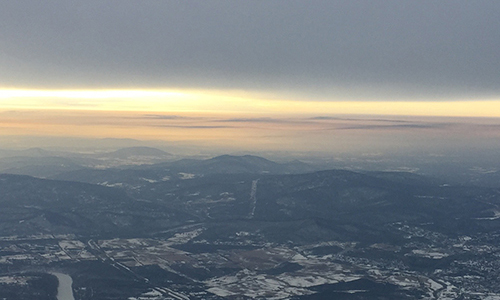A .gov website belongs to an official government organization in the United States.
A lock () or https:// means you've safely connected to the .gov website. Share sensitive information only on official, secure websites.
23 July 2018
adapted from the story by CIRES Communications

The air in the United States is much cleaner than even a decade ago. But those improvements have come mainly in summer, the season that used to be the poster child for haze-containing particles that cause asthma, lung cancer and other illnesses.
Eastern U.S. air pollution levels are more stagnant in winter. A new study led by the University of Washington shows why winter air pollution levels have remained high, despite overall lower levels of harmful emissions from power plants and vehicles throughout the year.
"The devil's in the chemistry details," said coauthor Jose Jimenez of CIRES at CU Boulder. "What we've learned is that wintertime chemistry can play some unanticipated tricks, making air-pollution-forming reactions more efficient even as the emissions behind that chemistry decrease. Steeper future emissions reductions will be required to achieve winter air quality improvements."
"We could only figure this out by making a very comprehensive set of chemical measurements," added coauthor Steven Brown of CSD at NOAA Boulder. "Our study was the first of its kind to include all of the major air pollutants that are relevant to understanding the winter from an aircraft. This detailed knowledge of winter air composition has enabled more accurate predictions of future air quality in the Eastern United States."

The study, published this week in the Proceedings of the National Academy of Sciences, shows that the particles follow different pathways in the winter.
Results came from analyzing observations collected during the 2015 Wintertime Investigation of Transport, Emissions and Reactivity (WINTER) campaign. During that UW-led effort, researchers spent six weeks in winter flying through pollution plumes over New York City, Baltimore, Cincinnati, Columbus, Pittsburgh, Washington, D.C., and along the coal-fired power plants of the Ohio River Valley. The study was funded by the National Science Foundation (NSF), with in-kind support from NASA and NOAA.
Shah, V., L. Jaeglé, J.A. Thornton, F.D. Lopez-Hilfiker, B.H. Lee, J.C. Schroder, P. Campuzano-Jost, J.L. Jimenez, H. Guo, A.P. Sullivan, R.J. Weber, J.R. Green, M.N. Fiddler, S. Bililign, T.L. Campos, M. Stell, A.J. Weinheimer, D.D. Montzka, and S.S. Brown, Chemical feedbacks weaken the wintertime response of particulate sulfate and nitrate to emissions reductions over the eastern United States, Proceedings of the National Academy of Sciences, doi:10.1073/pnas.1803295115, 2018.
2−4) and nitrate (NO−3) account for half of the fine particulate matter mass over the eastern United States. Their wintertime concentrations have changed little in the past decade despite considerable precursor emissions reductions. The reasons for this have remained unclear because detailed observations to constrain the wintertime gas–particle chemical system have been lacking. We use extensive airborne observations over the eastern United States from the 2015 Wintertime Investigation of Transport, Emissions, and Reactivity (WINTER) campaign; ground-based observations; and the GEOS-Chem chemical transport model to determine the controls on winter SO2−4 and NO−3. GEOS-Chem reproduces observed SO2−4–NO−3–NH+4 particulate concentrations (2.45 μg sm−3) and composition (SO2−4: 47%; NO−3: 32%; NH+4: 21%) during WINTER. Only 18% of SO2 emissions were regionally oxidized to SO2−4 during WINTER, limited by low [H2O2] and [OH]. Relatively acidic fine particulates (pH∼1.3) allow 45% of nitrate to partition to the particle phase. Using GEOS-Chem, we examine the impact of the 58% decrease in winter SO2 emissions from 2007 to 2015 and find that the H2O2 limitation on SO2 oxidation weakened, which increased the fraction of SO2 emissions oxidizing to SO2−4. Simultaneously, NOx emissions decreased by 35%, but the modeled NO−3 particle fraction increased as fine particle acidity decreased. These feedbacks resulted in a 40% decrease of modeled [SO2−4] and no change in [NO−3], as observed. Wintertime [SO2−4] and [NO−3] are expected to change slowly between 2015 and 2023, unless SO2 and NOx emissions decrease faster in the future than in the recent past.